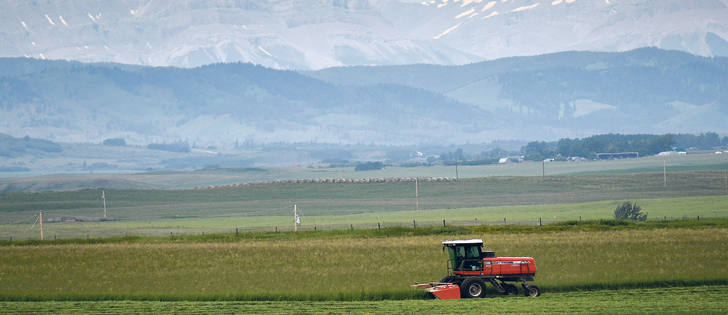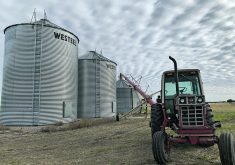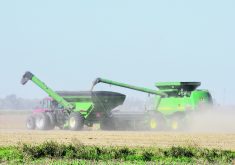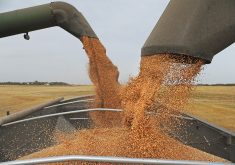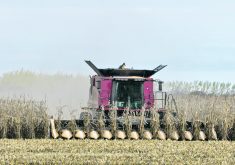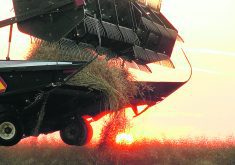MANITOBA
SOUTHWEST
Precipitation varied from three to 20 millimetres along with wind, cooler than normal temperatures and a severe hailstorm.
Iron deficiency chlorosis in soybeans and cool, wet weather have made symptoms more severe.
Alfalfa weevil damage is widespread and quite severe in some cases.
NORTHWEST
Rainfall ranged from 12 to 25 mm along with cool temperatures near zero in some areas.
Surface soil moisture is excessive and less than 10 percent of the crop is seeded.
Read Also

Using artificial intelligence in agriculture starts with the right data
Good data is critical as the agriculture sector increasingly adopts new AI technology to drive efficiency, sustainability and trust across all levels of the value chain.
Cattle are grazing hayland in The Pas. There is concern about feed supplies for the winter.
CENTRAL
Precipitation varied from five to 20 mm along with cooler temperatures and high winds.
Yellowing is evident in many soybean fields, although some recovery is noticeable.
Rain is delaying haying and lower yields are expected because of short stands.
EASTERN
Rainfall ranged from six to 25 mm. Cool temperatures and wind have slowed crop development considerably.
Iron deficiency chlorosis has appeared in soybeans across large areas as well as stress from herbicide applications and the initiation of nitrogen fixation.
Hay fields and pasture conditions are rated 80 percent good and 20 percent fair.
INTERLAKE
Precipitation varied from eight to 29 mm with good moisture and crop development.
Alfalfa weevil larvae and aphids feeding on hay stands have caused delayed flowering and lower yield and quality.
Leaf cutter bees are in the second and fourth weeks of incubation.
SASKATCHEWAN
SOUTHEAST
Precipitation varied from small amounts to 12 millimetres along with strong winds.
Due to unfavourable growing conditions, 45 percent of oilseeds, 29 percent of pulses, 33 percent of spring cereals and 12 percent of fall cereals are behind their normal stage of development.
Topsoil moisture conditions on cropland, hayland and pastures have an average rating of 59 percent adequate and 32 percent short.
SOUTHWEST
Rainfall ranged from small amounts to 16 mm along with strong winds.
Forty-two percent of oilseeds, 44 percent of pulses, 35 percent of spring cereals and 10 percent of fall cereals are behind normal development.
Topsoil moisture conditions on cropland are rated 29 percent adequate, 57 percent short and 14 percent very short, while hayland and pastures are 20 percent adequate, 53 percent short and 27 percent very short.
EAST-CENTRAL
Precipitation varied from small amounts to 17 mm with strong winds and cool temperatures.
Topsoil moisture on cropland, hayland and pastures have an average rating of 73 percent adequate and 21 percent short.
Slower crop development in some areas has 46 percent of oilseeds, 28 percent of pulses, 41 percent of spring cereals and 21 percent of fall cereals behind normal development.
WEST-CENTRAL
Rainfall ranged from small amounts to 25 mm along with strong winds and cool temperatures.
Unfavourable growing conditions have slowed crop development in some areas with 30 percent of oilseeds, 22 percent of pulses, 30 percent of spring cereals and six percent of fall cereals behind their normal stages of development.
Topsoil moisture conditions on cropland are rated 71 percent adequate and 26 percent short, while hayland and pastures are 62 percent adequate and 33 percent short.
NORTHEAST
Precipitation varied from small amounts to 57 mm in the Nipawin area, which holds the provincial record of 360 mm for the greatest amount of rainfall since April 1.
Slow crop development has 60 percent of oilseeds, 54 percent of pulses and spring cereals and 42 percent of fall cereals behind.
Topsoil moisture conditions on cropland, hayland and pastures have an average rating of 25 percent surplus, 70 percent adequate and four percent short.
NORTHWEST
Rainfall ranged from 40 mm along with strong winds and cool temperatures.
Topsoil moisture conditions on cropland, hayland and pastures have an average rating of 15 percent surplus, 73 percent adequate and 12 percent short.
Forty-three percent of oilseeds, 13 percent of pulses and 42 percent of spring cereals are behind normal development.
ALBERTA
SOUTH
Precipitation varied from five to 10 millimetres.
Crop condition ratings are 83 percent good or excellent, while surface soil moisture is rated 66 percent good or excellent.
First cut dryland haying is 39 percent complete, and irrigated haying is 57 percent complete.
CENTRAL
Rainfall ranged from five to 10 mm with dry, windy conditions.
Crop condition ratings are 81 percent good or excellent, and surface soil moisture ratings are 70 percent good or excellent.
First cut dryland haying is eight percent completed.
NORTHEAST
Precipitation varied from 10 to 20 mm, crops are being affected by excessive moisture laying in fields and yellowing is becoming prominent.
Crop condition ratings are 83 percent good or excellent and surface soil moisture ratings are 64 percent good or excellent.
First cut dryland haying is one percent complete.
NORTHWEST
Precipitation varied from 10 to 20 mm and crops are yellowing.
Crops are rated 60 percent good or excellent compared to the five year average of 75 percent. Surface soil moisture ratings are 62 percent good or excellent.
First cut dryland haying is one percent completed.
PEACE
Rainfall ranged from 10 to 20 mm.
Crop condition ratings are 65 percent rated good or excellent while surface soil moisture ratings are 75 percent good or excellent.
Harvest of first cut dryland hay has not started.

